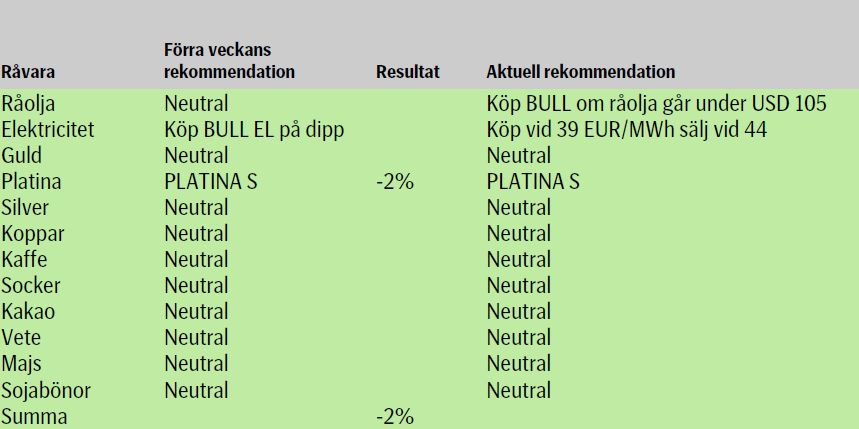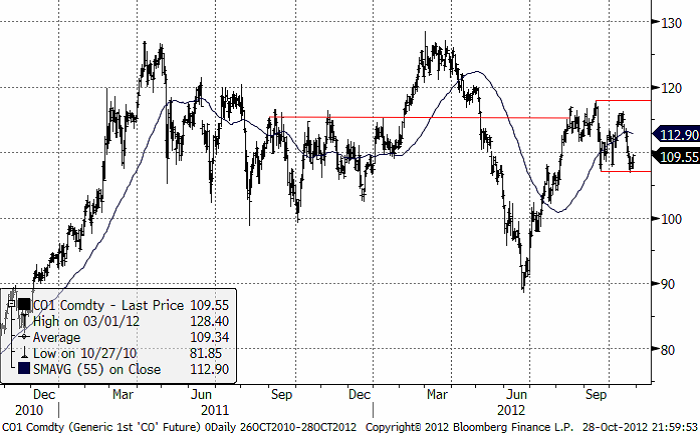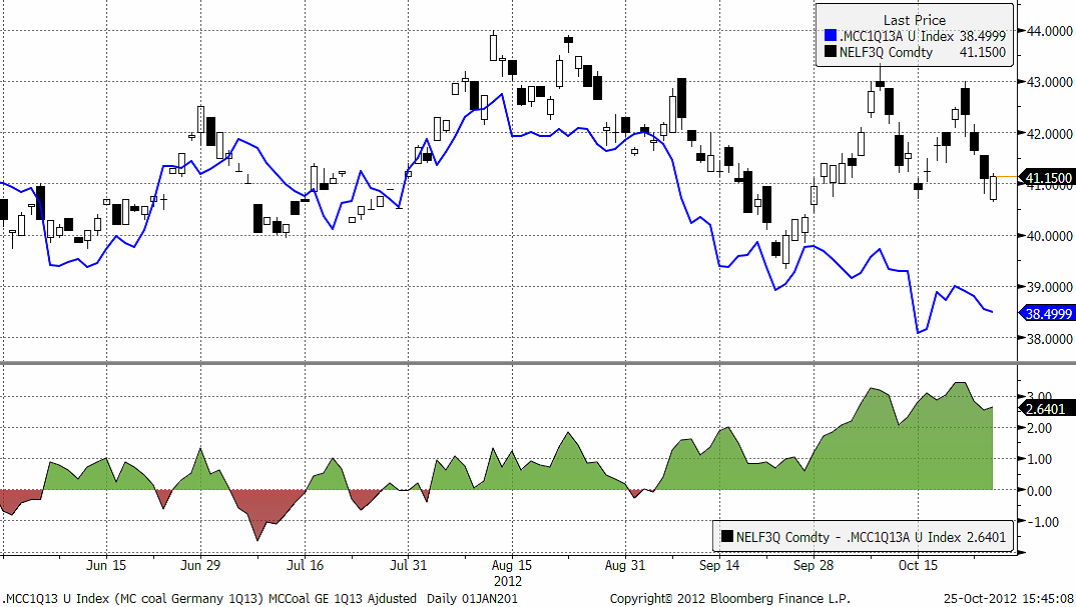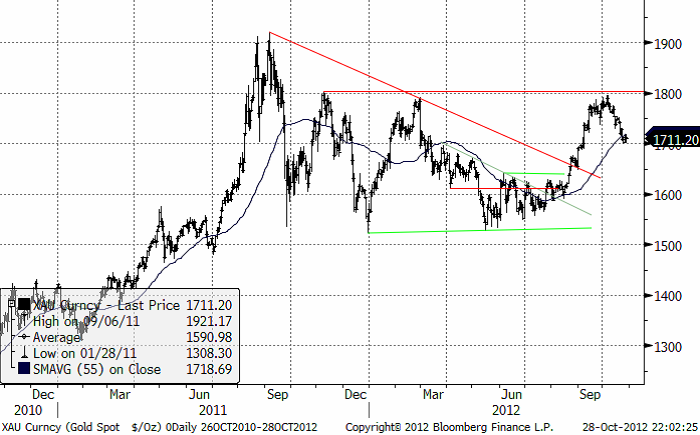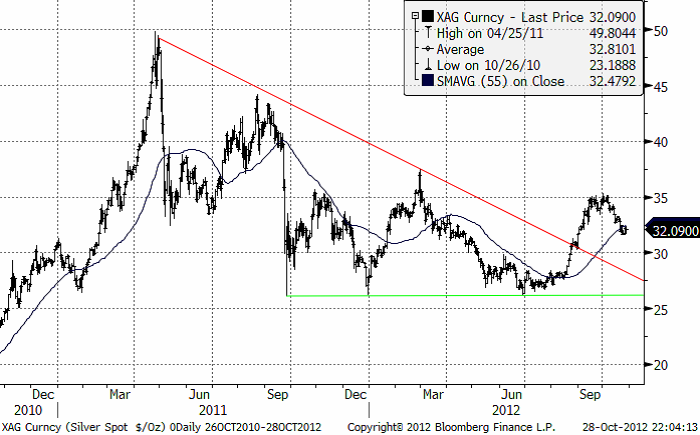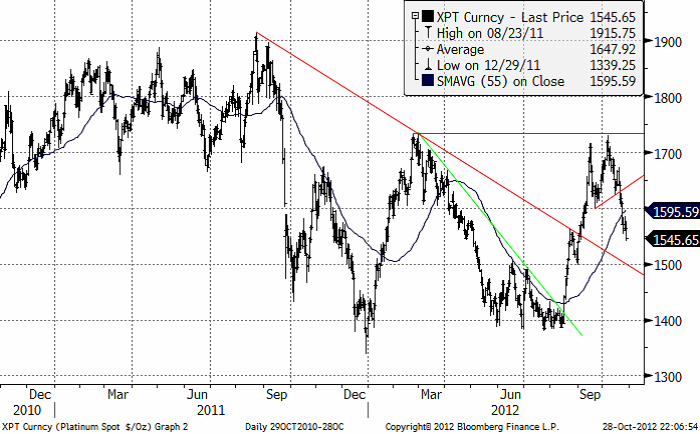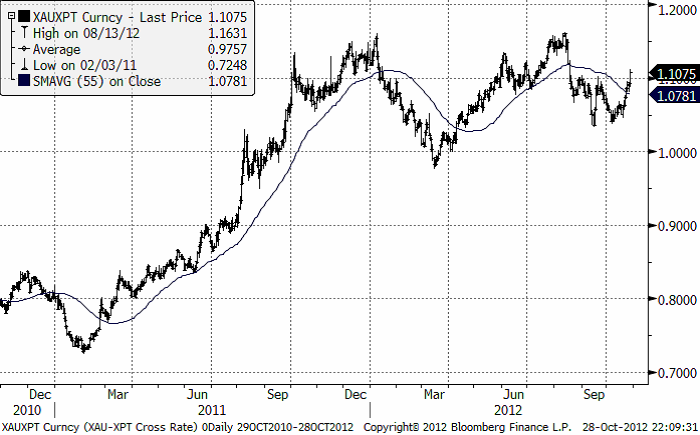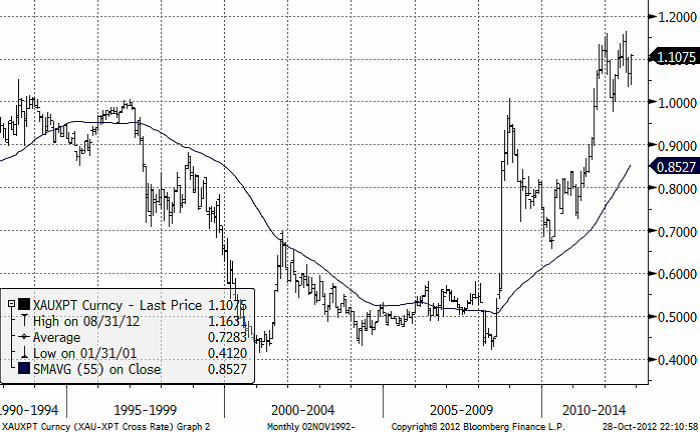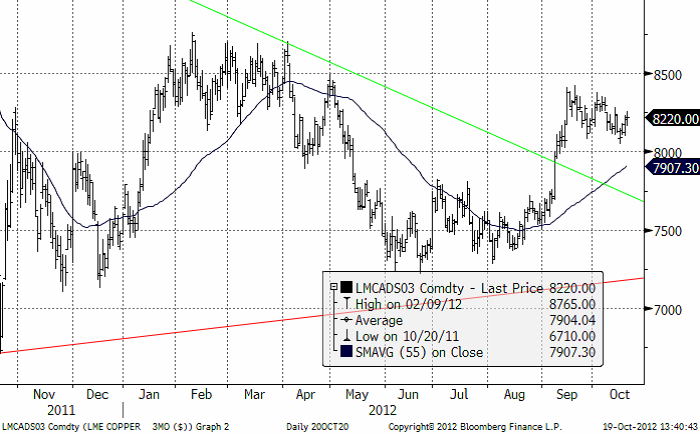Analys
SEB – Råvarukommentarer, 29 oktober 2012
Sammanfattning av rekommendationer
Råolja – Brent
Vi råder att köpa Brent-råolja vid nedgångar till under $105/fat eftersom det verkar osannolikt att priset på råolja kommer att rasa, såvida inte tillväxtprognoserna skrivs ned väsentligt. Vår uppfattning är att oljepriset kommer att fortsätta vara väl understött med tanke på stora geopolitiska risker för tillgången, strama marknader för oljeprodukter, höga incitamentpriser som krävs för att stimulera till tillräckliga investeringar, och behovet av att producentländer försvarar priser för att balansera budgetar. Vi behåller våra prognoser för genomsnittligt pris på Brent-råolja på $110/fat under Q4-12 och $105/fat under H1-13, men väljer att revidera våra uppskattningar för H2-13 och FY-14 från $115/fat till $110/fat. Prognoserna för tillgång förbättras vilket antyder en mindre stram balans på marknaden under de kommande åren, i synnerhet om tillväxten förblir matt.
Medan balansen på råoljemarknaden förblir lös är situationen för mellandestillat annorlunda. Över hela världen är förråden små. Situationen skulle verkligen kunna komma att bli väldigt stram så snart vinterns påfyllnad av bränslelagren accelererar i Europa, som förutsägbart är den stramaste marknaden med tanke på dess fordonspark av dieselbilar. En ännu svårare situation skulle kunna uppstå om temperaturerna på det norra halvklotet blir onormalt låga. Även under normala omständigheter är raffinaderier oförmögna att producera tillräckligt med mellandestillat under uppvärmningssäsongen, vilket gör förråden en nyckelfaktor vid balansering av marknaden. Den långsiktiga strukturella balansen för marknaden för mellandestillat är också oroande eftersom den leder tillväxt avseende efterfrågan. Under tiden har sannolikheten att USA släpper ut strategiska oljereserver uppenbarligen minskat i takt med att politiker inser att höga produktpriser beror på motsvarande strama marknader, och att uttömning av lager av råolja skulle vara ett ineffektivt sätt att pressa ned dem (till skillnad från deras europeiska motparter består amerikanska strategiska oljereserver nästan uteslutande av råolja).
Iran verkar vara alltmer ovilliga att återvända till förhandlingsbordet då försämringen av deras inhemska levnadsstandard fortsätter att accelerera, med potentiell baissebetonade priskonsekvenser om detta stämmer. Den stora frågan kvarstår: finns det en möjlig kompromiss som skulle kunna blidka världsopinionen samtidigt som den gör det möjligt för det iranska ledarskapet att undvika att offentligt förlora anseendet.
I kursdiagrammet ovan ser vi att 107 dollar har visat sig vara ett förhållandevis starkt stöd. 100 dollar är nästa stöd på nedsidan. Skulle 107 brytas är det inte uteslutet att marknaden vill testa 100 dollar. Det skulle i så fall vara ett köptillfälle, anser vi.
Elektricitet
Vi sänker vår föredragna utgångspunkt för haussepositioner till €39/MWh för Q1-2013-kontraktet på Nord Pool på grund av minskade marginalkostnader för kolkraftproduktion i Tyskland. Vi föredrar att handla kontraktet från haussesidan under november om denna utgångsnivå uppnås. Å andra sidan verkar €43/MWh till €44/MWh vara bra utgångspunkter för de som tar risken att handla vinterkontraktet NELFQ3 från säljsidan med BEAR EL X2 S eller med BEAR EL X4 S.
Hittills i oktober har Q1-2013-kontraktet (NELF3Q) på Nord Pool handlats för mellan €40,65/MWh och €43,35/MWh. Under den senaste veckan nådde det så högt som €43/MWh på grund av prognoser för kallare och torrare väderlek samt en studs i marginalkostnaden för kolkraftproduktion (MCCP). I skrivande stund har NELF3Q återigen fallit tillbaka på blöt väderlek och lägre marginalkostnadspriser och har faktiskt handlats på dess lägsta pris hittills i oktober. I och med att prognoser för blöt väderlek har återkommit står det totala vattenöverskottet stadigt på cirka 10 TWh mer än det normala för den här årstiden. Situationen med vattenöverskott naggar kraftkontrakten i frontmånaden i kanten och driver ned dem, samtidigt som NELF3Q-kontraktet fortsätter att upprätthålla riskpremien för vintern. Vi tror att kontraktet troligtvis kommer att bibehålla sin premie i åtminstone en månad innan ett eventuellt vattenöverskott till slut kommer att börja tära på kontraktet när tiden för leverans till snittet av de faktiska spotpriserna närmar sig. Fram till dess kommer de oundvikliga och tillfälliga torra och blöta väderperioderna att lyfta kontraktet tillbaka till nivån på €43/MWh eller högre.
Det som är oroande är att stödet från MCCP har fortsatt att försämras under oktober. Den tekniska bilden för kolpriser är direkt baissebetonad och priserna på koldioxid ser också svaga ut. Spridningen mellan NELF3Q och vårt MCCP-index (.MCC1Q13) har vidgats. Enligt vår uppfattning ökar detta nedåtrisken, vilket betyder att NELF3Q har längre väg att falla om det förlorar en del av sin riskpremie för vintern.
Vi tror fortfarande att det är tillrådligt att handla NELF3Q från haussesidan i november på grund av vintern och risken för brist på kärnkraft framöver. Vi har dock flyttat ned vår föredragna utgångsnivå från €40/MWh till €39/MW tillsammans med det lägre MCCP-indexet (.MCC1Q13). Å andra sidan verkar €43/MWh till €44/WMh vara bra utgångspunkter för de som tar risken att handla vinterkontraktet NELF3Q från säljsidan.
Guld och Silver
Kommentaren från förra veckan får stå kvar. ”Statistiken som kommer in nu är lite ”för stark” för guldet”. Veckans statistik har fortsatt på samma tema: en stadig, om än lite långsam återhämtning i USA. Frågan är dock om det räcker. centralbanken i USA, och i andra delar av världen för den delen, har tryck på sig att fortsätta med stimulanserna. Det ryktas om förestående ”paket” i Japan. Många ekonomer tror på ett amerikanskt QE4 före årsskiftet.
Nedan ser vi kursdiagrammet för guld.
Nedan ser vi kursdiagrammet för silver i dollar per troy ounce. Vi ser att 35 dollar är ett viktigt motstånd och att 30 dollar är ett viktigt stöd. En fortsatt nedgång till 30 dollar skulle vara ett bra köptillfälle. En stopp-loss-order bör då placeras strax under 30 dollar.
Platina
När både guld och basmetaller faller är det svårt för Platinametallerna att hålla emot. Proppen gick ur och vi såg ett kraftigt fall för både Platina och Palladium under veckan. Utbudsfaktorerna (kopplade till problemen i Sydafrika) hjälper inte när investerarkollektivet säljer. Londonnoteringen är ner ca 5 % i veckan till $1550/oz. Kortsiktigt finns risk för ytterligare fall. Med den tekniska analysen som vägledning bör marknaden hitta en bra stödnivå kring $1500. Kursen ligger nu just ovanför den konsolidering marknaden gjorde mellan 1500 och 1560 vid månadsskiftet augusti-september, innan marknaden bröt den nedåtgående trendlinjen. Det skulle inte förvåna om kursfallet bromsas upp, och kanske rent av vänder uppåt efter viss sidledes rörelse på de här nivåerna.
Nedan ser vi priset på guld dividerat med priset på platina. Platina har blivit billigare i förhållande till guld den senaste veckan. Vi anser att detta är ett bra argument för att sälja guld och köpa platina, allt annat lika, eller att köpa platina enbart.
Nedan ser vi kvoten mellan guld och platina för de senaste 20 åren. Vi ser att platina är exceptionellt dyrt i förhållande till guld ur ett historiskt perspektiv. Och vi bör komma ihåg att priser på råvaror på lång sikt bestäms av produktionskostnad. Medan platinagruvorna i Sydafrika inte går med vinst nu, är lönsamheten god för guldgruvorna i världen. På lång sikt talar detta för att platina är en bättre placering än vad guld är.
Koppar
Det negativa stämningsläget från LME-veckan tog överhanden för basmetallerna. Priserna har konstant fallit, inga direkta ras, men metallerna har sakta men säkert tuggat sig ner under veckan. Prisuppgången efter stimulansrundan i september är nu i de flesta fall nästa helt utraderad. Om priserna överreagerade på de kortsiktigt realekonomiska effekterna av penningstimulanserna, så känns det som en överreaktion på nedsidan nu istället. Det finns flera tecken på en makroekonomisk förbättring. Igår fredag redovisades amerikansk BNP för Q3 som kom in bättre än väntat och visar på en uppgång från 2:a kvartalet från 1,3 till 2,0 % i årstakt. Det går långsamt men åt rätt håll. Även i Kina ser det ut att bottna ur. Industriproduktionen ökar och inflationen är låg. Marknadens oro gäller inte beslutade infrastrukturinvesteringar, utan de lokala myndigheternas brist på finansiering. Ledningsbytet i Kina inger förhoppningar, men det återstår att se vad de kommer att presentera, och det kan dröja till installationen av den nya ledningen i början av nästa år. Metallimporten ökade i september, vilket är ett gott tecken (se nedan).
Koppar
Priset föll ca 2 % i veckan, från $8000 ned till ca 7800 för 3 månaders koppar på LME. De innebär att vi är tillbaka vid nivåerna i början av september. Kinas import av koppar kom in på fyramånadershögsta i september till ca 394 tton, upp från augustis 355 tton, eller ca 11 %. Under årets nio första månader har importen ökat med 32 % jämfört med förra året. Det ska inte glömmas bort att Kina har en fortsatt stor aptit på metallen. Kommentarer från Nexans, världens nästa största kabeltillverkare i veckan, noterade att substitutionseffekten mellan koppar och aluminium (koppar 4 ggr dyrare) i kablar än så länge är begränsad, och särskilt i Kina där kopparbaserad kabel är klart favoriserad. Vi föredrar att betrakta koppar som en köpvärdmetall. Kortsiktigt har vi den senaste veckan hållit oss neutrala men grundinställningen är att hitta köptillfällen.
För spannmål och övriga jordbruksprodukter hänvisas till förra veckans nyhetsbrev om Jordbruksprodukter.
[box]SEB Veckobrev Veckans råvarukommentar är producerat av SEB Merchant Banking och publiceras i samarbete och med tillstånd på Råvarumarknaden.se[/box]
Disclaimer
The information in this document has been compiled by SEB Merchant Banking, a division within Skandinaviska Enskilda Banken AB (publ) (“SEB”).
Opinions contained in this report represent the bank’s present opinion only and are subject to change without notice. All information contained in this report has been compiled in good faith from sources believed to be reliable. However, no representation or warranty, expressed or implied, is made with respect to the completeness or accuracy of its contents and the information is not to be relied upon as authoritative. Anyone considering taking actions based upon the content of this document is urged to base his or her investment decisions upon such investigations as he or she deems necessary. This document is being provided as information only, and no specific actions are being solicited as a result of it; to the extent permitted by law, no liability whatsoever is accepted for any direct or consequential loss arising from use of this document or its contents.
About SEB
SEB is a public company incorporated in Stockholm, Sweden, with limited liability. It is a participant at major Nordic and other European Regulated Markets and Multilateral Trading Facilities (as well as some non-European equivalent markets) for trading in financial instruments, such as markets operated by NASDAQ OMX, NYSE Euronext, London Stock Exchange, Deutsche Börse, Swiss Exchanges, Turquoise and Chi-X. SEB is authorized and regulated by Finansinspektionen in Sweden; it is authorized and subject to limited regulation by the Financial Services Authority for the conduct of designated investment business in the UK, and is subject to the provisions of relevant regulators in all other jurisdictions where SEB conducts operations. SEB Merchant Banking. All rights reserved.
Analys
The Mid-East anchor dragging crude oil lower

When it starts to move lower it moves rather quickly. Gaza, China, IEA. Brent crude is down 2.1% today to $62/b after having traded as high as $66.58/b last Thursday and above $70/b in late September. The sell-off follows the truce/peace in Gaze, a flareup in US-China trade and yet another bearish oil outlook from the IEA.

A lasting peace in Gaze could drive crude oil at sea to onshore stocks. A lasting peace in Gaza would probably calm down the Houthis and thus allow more normal shipments of crude oil to sail through the Suez Canal, the Red Sea and out through the Bab-el-Mandeb Strait. Crude oil at sea has risen from 48 mb in April to now 91 mb versus a pre-Covid normal of about 50-60 mb. The rise to 91 mb is probably the result of crude sailing around Africa to be shot to pieces by the Houthis. If sailings were to normalize through the Suez Canal, then it could free up some 40 mb in transit at sea moving onshore into stocks.
The US-China trade conflict is of course bearish for demand if it continues.
Bearish IEA yet again. Getting closer to 2026. Credibility rises. We expect OPEC to cut end of 2025. The bearish monthly report from the IEA is what it is, but the closer we get to 2026, the more likely the IEA is of being ball-park right in its outlook. In its monthly report today the IEA estimates that the need for crude oil from OPEC in 2026 will be 25.4 mb/d versus production by the group in September of 29.1 mb/d. The group thus needs to do some serious cutting at the end of 2025 if it wants to keep the market balanced and avoid inventories from skyrocketing. Given that IEA is correct that is. We do however expect OPEC to implement cuts to avoid a large increase in inventories in Q1-26. The group will probably revert to cuts either at its early December meeting when they discuss production for January or in early January when they discuss production for February. The oil price will likely head yet lower until the group reverts to cuts.
Dubai: The Mid-East anchor dragging crude oil lower. Surplus emerging in Mid-East pricing. Crude oil prices held surprisingly strong all through the summer. A sign and a key source of that strength came from the strength in the front-end backwardation of the Dubai crude oil curve. It held out strong from mid-June and all until late September with an average 1-3mth time-spread premium of $1.8/b from mid-June to end of September. The 1-3mth time-spreads for Brent and WTI however were in steady deterioration from late June while their flat prices probably were held up by the strength coming from the Persian Gulf. Then in late September the strength in the Dubai curve suddenly collapsed. Since the start of October it has been weaker than both the Brent and the WTI curves. The Dubai 1-3mth time-spread now only stands at $0.25/b. The Middle East is now exporting more as it is producing more and also consuming less following elevated summer crude burn for power (Aircon) etc.
The only bear-element missing is a sudden and solid rise in OECD stocks. The only thing that is missing for the bear-case everyone have been waiting for is a solid, visible rise in OECD stocks in general and US oil stocks specifically. So watch out for US API indications tomorrow and official US oil inventories on Thursday.
No sign of any kind of fire-sale of oil from Saudi Arabia yet. To what we can see, Saudi Arabia is not at all struggling to sell its oil. It only lowered its Official Selling Prices (OSPs) to Asia marginally for November. A surplus market + Saudi determination to sell its oil to the market would normally lead to a sharp lowering of Saudi OSPs to Asia. Not yet at least and not for November.
The 5yr contract close to fixed at $68/b. Of importance with respect to how far down oil can/will go. When the oil market moves into a surplus then the spot price starts to trade in a large discount to the 5yr contract. Typically $10-15/b below the 5yr contract on average in bear-years (2009, 2015, 2016, 2020). But the 5yr contract is usually pulled lower as well thus making this approach a moving target. But the 5yr contract price has now been rock solidly been pegged to $68/b since 2022. And in the 2022 bull-year (Brent spot average $99/b), the 5yr contract only went to $72/b on average. If we assume that the same goes for the downside and that 2026 is a bear-year then the 5yr goes to $64/b while the spot is trading at a $10-15/b discount to that. That would imply an average spot price next year of $49-54/b. But that is if OPEC doesn’t revert to cuts and instead keeps production flowing. We think OPEC(+) will trim/cut production as needed into 2026 to prevent a huge build-up in global oil stocks and a crash in prices. But for now we are still heading lower. Into the $50ies/b.
Analys
More weakness and lower price levels ahead, but the world won’t drown in oil in 2026

Some rebound but not much. Brent crude rebounded 1.5% yesterday to $65.47/b. This morning it is inching 0.2% up to $65.6/b. The lowest close last week was on Thursday at $64.11/b.

The curve structure is almost as week as it was before the weekend. The rebound we now have gotten post the message from OPEC+ over the weekend is to a large degree a rebound along the curve rather than much strengthening at the front-end of the curve. That part of the curve structure is almost as weak as it was last Thursday.
We are still on a weakening path. The message from OPEC+ over the weekend was we are still on a weakening path with rising supply from the group. It is just not as rapidly weakening as was feared ahead of the weekend when a quota hike of 500 kb/d/mth for November was discussed.
The Brent curve is on its way to full contango with Brent dipping into the $50ies/b. Thus the ongoing weakening we have had in the crude curve since the start of the year, and especially since early June, will continue until the Brent crude oil forward curve is in full contango along with visibly rising US and OECD oil inventories. The front-month Brent contract will then flip down towards the $60/b-line and below into the $50ies/b.
At what point will OPEC+ turn to cuts? The big question then becomes: When will OPEC+ turn around to make some cuts? At what (price) point will they choose to stabilize the market? Because for sure they will. Higher oil inventories, some more shedding of drilling rigs in US shale and Brent into the 50ies somewhere is probably where the group will step in.
There is nothing we have seen from the group so far which indicates that they will close their eyes, let the world drown in oil and the oil price crash to $40/b or below.
The message from OPEC+ is also about balance and stability. The world won’t drown in oil in 2026. The message from the group as far as we manage to interpret it is twofold: 1) Taking back market share which requires a lower price for non-OPEC+ to back off a bit, and 2) Oil market stability and balance. It is not just about 1. Thus fretting about how we are all going to drown in oil in 2026 is totally off the mark by just focusing on point 1.
When to buy cal 2026? Before Christmas when Brent hits $55/b and before OPEC+ holds its last meeting of the year which is likely to be in early December.
Brent crude oil prices have rebounded a bit along the forward curve. Not much strengthening in the structure of the curve. The front-end backwardation is not much stronger today than on its weakest level so far this year which was on Thursday last week.

The front-end backwardation fell to its weakest level so far this year on Thursday last week. A slight pickup yesterday and today, but still very close to the weakest year to date. More oil from OPEC+ in the coming months and softer demand and rising inventories. We are heading for yet softer levels.

Analys
A sharp weakening at the core of the oil market: The Dubai curve

Down to the lowest since early May. Brent crude has fallen sharply the latest four days. It closed at USD 64.11/b yesterday which is the lowest since early May. It is staging a 1.3% rebound this morning along with gains in both equities and industrial metals with an added touch of support from a softer USD on top.

What stands out the most to us this week is the collapse in the Dubai one to three months time-spread.
Dubai is medium sour crude. OPEC+ is in general medium sour crude production. Asian refineries are predominantly designed to process medium sour crude. So Dubai is the real measure of the balance between OPEC+ holding back or not versus Asian oil demand for consumption and stock building.
A sharp weakening of the front-end of the Dubai curve. The front-end of the Dubai crude curve has been holding out very solidly throughout this summer while the front-end of the Brent and WTI curves have been steadily softening. But the strength in the Dubai curve in our view was carrying the crude oil market in general. A source of strength in the crude oil market. The core of the strength.
The now finally sharp decline of the front-end of the Dubai crude curve is thus a strong shift. Weakness in the Dubai crude marker is weakness in the core of the oil market. The core which has helped to hold the oil market elevated.
Facts supports the weakening. Add in facts of Iraq lifting production from Kurdistan through Turkey. Saudi Arabia lifting production to 10 mb/d in September (normal production level) and lifting exports as well as domestic demand for oil for power for air con is fading along with summer heat. Add also in counter seasonal rise in US crude and product stocks last week. US oil stocks usually decline by 1.3 mb/week this time of year. Last week they instead rose 6.4 mb/week (+7.2 mb if including SPR). Total US commercial oil stocks are now only 2.1 mb below the 2015-19 seasonal average. US oil stocks normally decline from now to Christmas. If they instead continue to rise, then it will be strongly counter seasonal rise and will create a very strong bearish pressure on oil prices.
Will OPEC+ lift its voluntary quotas by zero, 137 kb/d, 500 kb/d or 1.5 mb/d? On Sunday of course OPEC+ will decide on how much to unwind of the remaining 1.5 mb/d of voluntary quotas for November. Will it be 137 kb/d yet again as for October? Will it be 500 kb/d as was talked about earlier this week? Or will it be a full unwind in one go of 1.5 mb/d? We think most likely now it will be at least 500 kb/d and possibly a full unwind. We discussed this in a not earlier this week: ”500 kb/d of voluntary quotas in October. But a full unwind of 1.5 mb/d”
The strength in the front-end of the Dubai curve held out through summer while Brent and WTI curve structures weakened steadily. That core strength helped to keep flat crude oil prices elevated close to the 70-line. Now also the Dubai curve has given in.

Brent crude oil forward curves

Total US commercial stocks now close to normal. Counter seasonal rise last week. Rest of year?

Total US crude and product stocks on a steady trend higher.

-

 Nyheter4 veckor sedan
Nyheter4 veckor sedanTyskland har så höga elpriser att företag inte har råd att använda elektricitet
-

 Nyheter3 veckor sedan
Nyheter3 veckor sedanOPEC+ missar produktionsmål, stöder oljepriserna
-

 Nyheter3 veckor sedan
Nyheter3 veckor sedanEtt samtal om guld, olja, fjärrvärme och förnybar energi
-

 Analys4 veckor sedan
Analys4 veckor sedanBrent crude ticks higher on tension, but market structure stays soft
-

 Nyheter2 veckor sedan
Nyheter2 veckor sedanGuld nära 4000 USD och silver 50 USD, därför kan de fortsätta stiga
-

 Analys3 veckor sedan
Analys3 veckor sedanAre Ukraine’s attacks on Russian energy infrastructure working?
-

 Nyheter2 veckor sedan
Nyheter2 veckor sedanBlykalla och amerikanska Oklo inleder ett samarbete
-

 Nyheter3 veckor sedan
Nyheter3 veckor sedanGuldpriset uppe på nya höjder, nu 3750 USD



